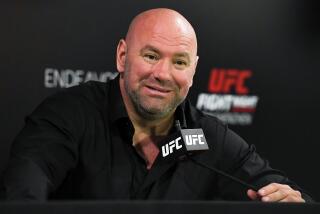Sugar Ray’s Plan Was Marvelous
- Share via
When Sugar Ray Leonard beat Marvelous Marvin Hagler in Las Vegas last year, he shredded several of boxing’s longest-cherished dogmas in the process.
Among them:
--They never come back.
--A good big man will always beat a good little man.
--When in doubt, stick with the champion.
Sugar Ray was the first fighter who wasn’t lured out of retirement. It was entirely his own idea. Poor old Jim Jeffries was hauled out--after five years--to restore the pride of the white man, whatever that is. There’s no evidence it was Jeff’s idea.
The others returned because they needed the money. Jack Johnson, Jack Dempsey, Joe Louis and even Benny Leonard had to get back in because they were broke.
Sugar Ray got back in because if there was one thing he knew in this world, it was that he could beat Marvin Hagler.
It galled him to read stories in print about Hagler being the best ever at the weight. To Sugar Ray, they were “negative” stories.
Sugar Ray hated being treated as a picture on the wall, a name in a book. Sugar Ray didn’t feel he was ancient history. He hadn’t fought in three years but he felt as if all he had to do was get out of bed and beat Marvin Hagler.
Most people think Sugar Ray Leonard found out he could beat Marvin Hagler with 2 minutes to go in the 12th and final round of their fight.
Not so. Sugar Ray found out he could beat Marvin Hagler the first time he saw Hagler fight from ringside.
A fighter has to have a good jab, fast hands, a big punch. He also has to have a big ego. Center ring is no place for self-doubts.
It is Sugar Ray’s contention that Marvin Hagler had plenty of them. The notion was reinforced when the fighters took off on a transcontinental publicity tour.
“The reporters kept asking me, ‘But what if you lose?’ I told them. ‘Don’t be asking me that question. Ask that man over there.’ And I’d point to Marvin Hagler. ‘He’s the one going to be doing the losing.’ Pretty soon, Marvin dropped off the tour.”
In the third round on their fight night, Sugar Ray recalls, “I looked into his face, and I knew he didn’t want to be there. He knew he had made a terrible mistake.”
The boxing world still couldn’t believe it. They told themselves they were looking at some kind of mirage. There had to be a catch. They talked themselves into thinking the fight had been closer than it was, that Hagler really had won it.
They pointed out that Leonard had insisted on 10-ounce gloves, a 20-foot ring. But although glove weight is negotiable in the pros, the rule of thumb in world amateur boxing is that 8-ounce gloves are used up to the 147-pound division and 10-ounce gloves thereafter. And 20-foot rings are the norm.
The real proof of the outcome, Sugar Ray says, is that Hagler not only did not press for a rematch, he avoided it. “He knows I’ll knock him out next time,” scorns Ray.
Still, the fight mob was outraged by this little Olympic upstart flouting its most sacred superstitions. Pugilistic theology demands he get what’s coming to him.
That may be several million more dollars--which he doesn’t need.
Boxing better get used to it. Sugar Ray is going to move up yet another rung in class when he takes on the World Boxing Council’s light-heavyweight champion, who turns out to be a Canadian named Donny Lalonde, in a 168-pound match at Caesars Palace in Las Vegas Nov. 7.
“I will never retire again,” promised Sugar Ray. “You will never ever, ever hear me say that horrible word retirement again.”
A year and a half ago, Sugar Ray’s comeback at the time of the Hagler fight seemed the most ill-advised since Napoleon’s. After all, he had retired at the top of the heap, glorified, almost deified, a man who had lost only one fight in his entire life--to Roberto Duran, since avenged. He had millions of dollars, a network contract, three cars in the garage, a mansion on the Potomac.
He hated it.
“Some people are cut out for suburbia,” he says. “Some people don’t like challenges.”
Some people like to smell the roses. Sugar Ray liked to smell the rosin. He didn’t want the bright lights, he wanted the ring lights. He didn’t want the quiet of a rose garden. He wanted the roar of a Madison Square Garden.
How lofty are his ambitions?
On a limousine ride to an airport the other day, someone asked Sugar Ray if Mike Tyson, like Marvin Hagler, looked as if he, too, could be beaten--say, by a clever, fast-hitting, fast-moving lighter foe. Sugar Ray looked thoughtful.
“Has it ever been done?” he wondered.
“Back in the ‘30s,” he was told, “Mickey Walker, who had been welterweight and middleweight champion, fought Jack Sharkey, who became heavyweight champion the next year, to a draw. He beat Johnny Risko, Paulino Uzcudun and King Levinsky, who were heavyweights. But he got knocked out by Max Schmeling.”
Sugar Ray nodded. “What did he weigh?”
“One-sixty-eight,” he was told. “Billy Conn weighed 170 when he fought Joe Louis.”
Sugar Ray looked interested. “I could weigh 170,” he said.
If I were Mike Tyson, I’d start going to bed earlier. Because the one law of boxing Sugar Ray hasn’t yet tampered with is, “The bigger they are, the harder they fall.”
More to Read
Go beyond the scoreboard
Get the latest on L.A.'s teams in the daily Sports Report newsletter.
You may occasionally receive promotional content from the Los Angeles Times.










